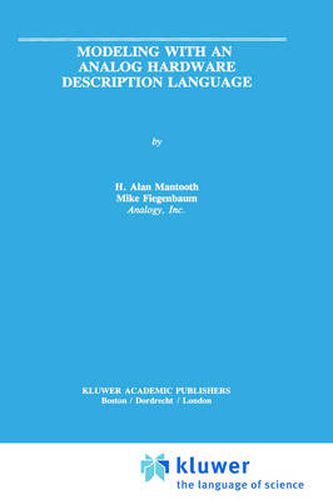Readings Newsletter
Become a Readings Member to make your shopping experience even easier.
Sign in or sign up for free!
You’re not far away from qualifying for FREE standard shipping within Australia
You’ve qualified for FREE standard shipping within Australia
The cart is loading…






This title is printed to order. This book may have been self-published. If so, we cannot guarantee the quality of the content. In the main most books will have gone through the editing process however some may not. We therefore suggest that you be aware of this before ordering this book. If in doubt check either the author or publisher’s details as we are unable to accept any returns unless they are faulty. Please contact us if you have any questions.
This text spells out, in general terms, what modelling with an analog hardware description language (AHDL) adds to the existing field of computer simulation, using specific examples to develop this understanding. The book is divided into three major sections: Fundamentals of Modeling provides an overview of general modelling and simulation concepts that are used in subsequent chapters. These introductory chapters cover topics such as macromodels, behavioural models, primitive device models, modelling hierarchy, top-down design, non-electrical technologies, and the Newton-Raphson iterative simulation technique. These topics are presented to help further the understanding of what is needed to develop models in an AHDL. Model Implementation begins to convey the implementation details of the MAST AHDL. The chapters in this section show how to use the governing equations of several commonly used models, along with equations that are readily available from well-known textbooks and papers. This information is provided in both tutorial and reference fashion, serving as an introduction to the basics of the MAST ADHL. Each chapter builds on the information from preceding chapters in order to demonstrate progressively more complex modelling concepts. This culminates with the diode and MOSFET models given in Chapter 9, which are intended to show the depth of the MAST language and which may be of interest to a more specialized segment of the modelling population. Advanced Applications contains several examples of designs that use models written in the MAST ADHL. Each example makes use of concepts brought up in the first two sections. The main purpose of these chapters is to illustrate the importance of using an AHDL to enhance the power of computer simulations.
$9.00 standard shipping within Australia
FREE standard shipping within Australia for orders over $100.00
Express & International shipping calculated at checkout
This title is printed to order. This book may have been self-published. If so, we cannot guarantee the quality of the content. In the main most books will have gone through the editing process however some may not. We therefore suggest that you be aware of this before ordering this book. If in doubt check either the author or publisher’s details as we are unable to accept any returns unless they are faulty. Please contact us if you have any questions.
This text spells out, in general terms, what modelling with an analog hardware description language (AHDL) adds to the existing field of computer simulation, using specific examples to develop this understanding. The book is divided into three major sections: Fundamentals of Modeling provides an overview of general modelling and simulation concepts that are used in subsequent chapters. These introductory chapters cover topics such as macromodels, behavioural models, primitive device models, modelling hierarchy, top-down design, non-electrical technologies, and the Newton-Raphson iterative simulation technique. These topics are presented to help further the understanding of what is needed to develop models in an AHDL. Model Implementation begins to convey the implementation details of the MAST AHDL. The chapters in this section show how to use the governing equations of several commonly used models, along with equations that are readily available from well-known textbooks and papers. This information is provided in both tutorial and reference fashion, serving as an introduction to the basics of the MAST ADHL. Each chapter builds on the information from preceding chapters in order to demonstrate progressively more complex modelling concepts. This culminates with the diode and MOSFET models given in Chapter 9, which are intended to show the depth of the MAST language and which may be of interest to a more specialized segment of the modelling population. Advanced Applications contains several examples of designs that use models written in the MAST ADHL. Each example makes use of concepts brought up in the first two sections. The main purpose of these chapters is to illustrate the importance of using an AHDL to enhance the power of computer simulations.